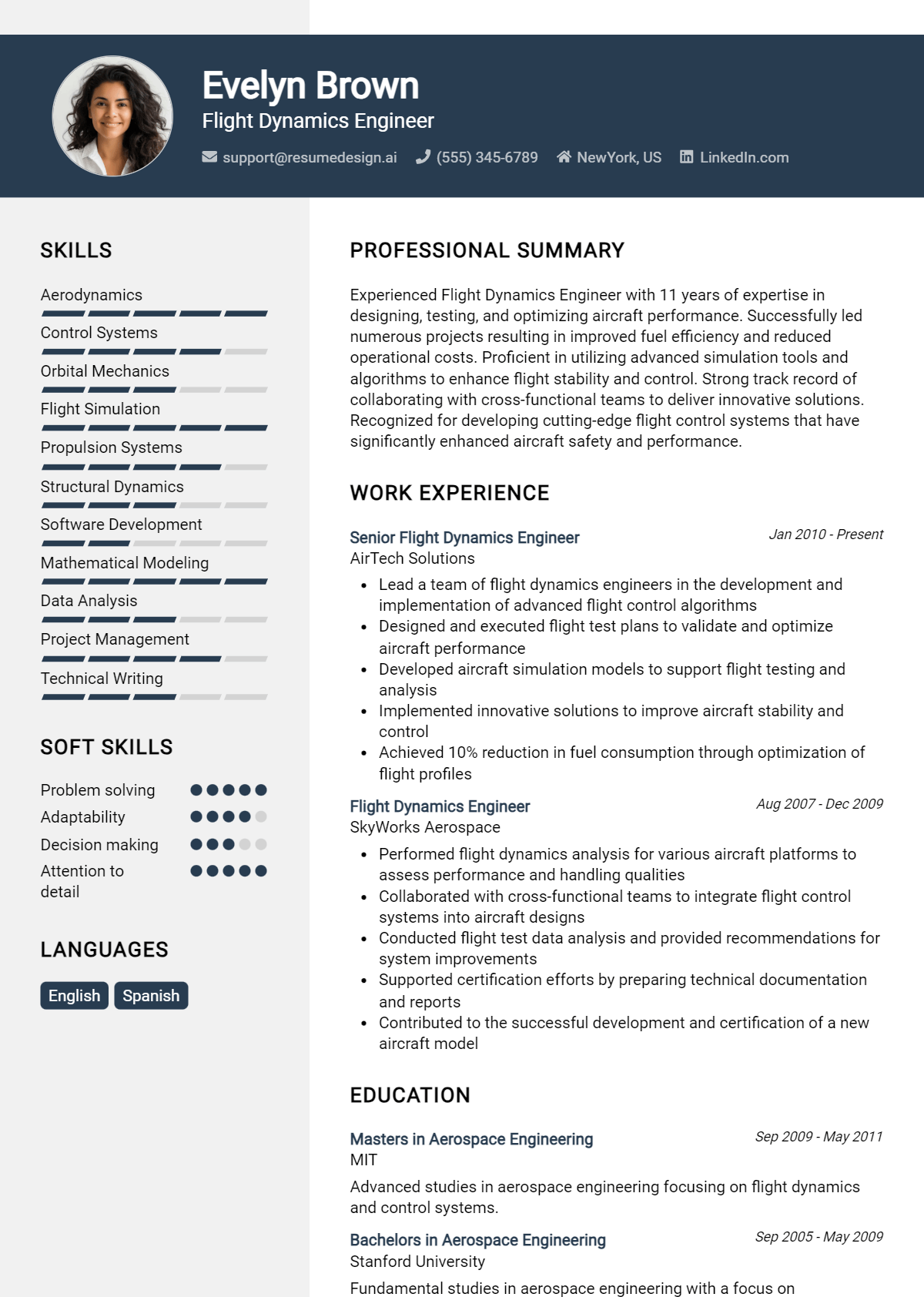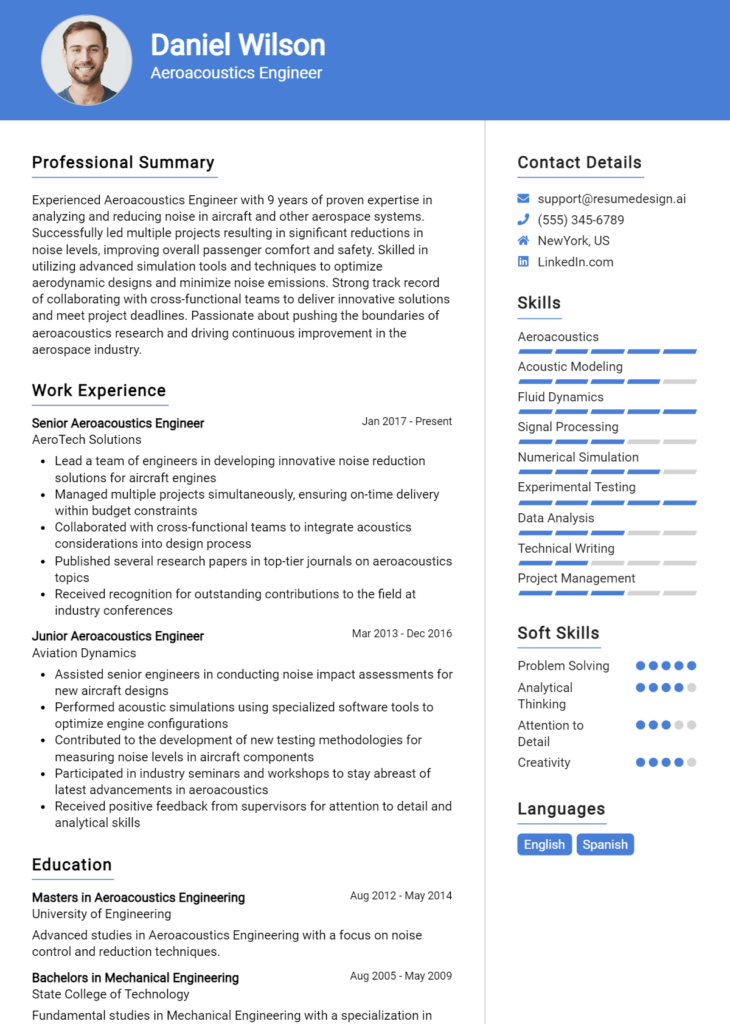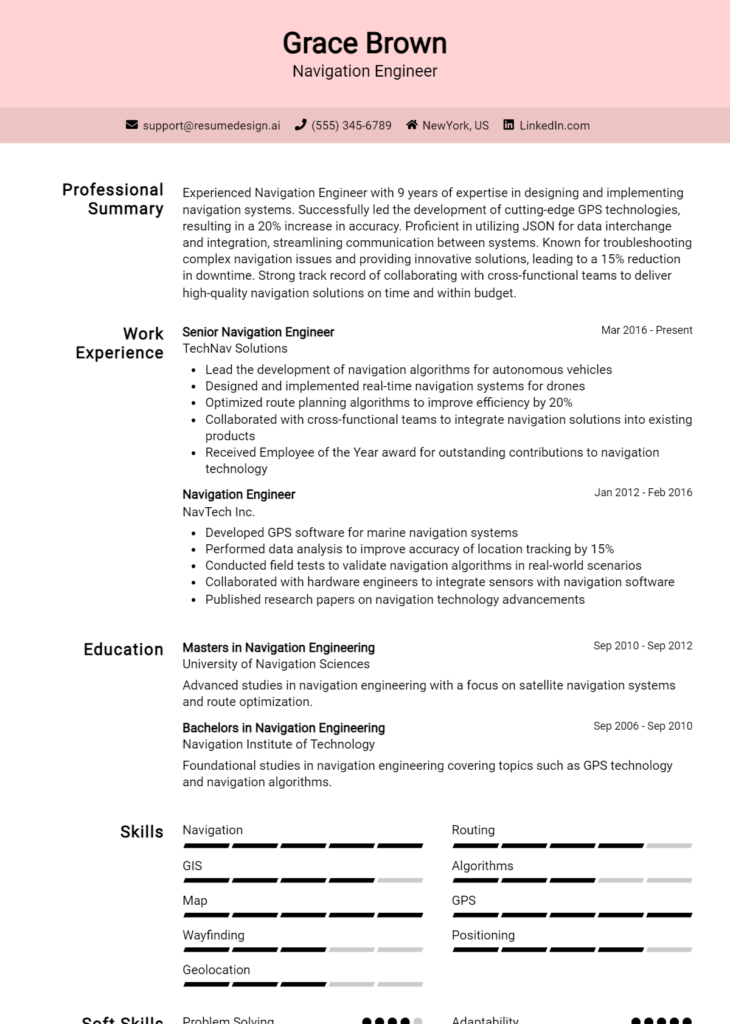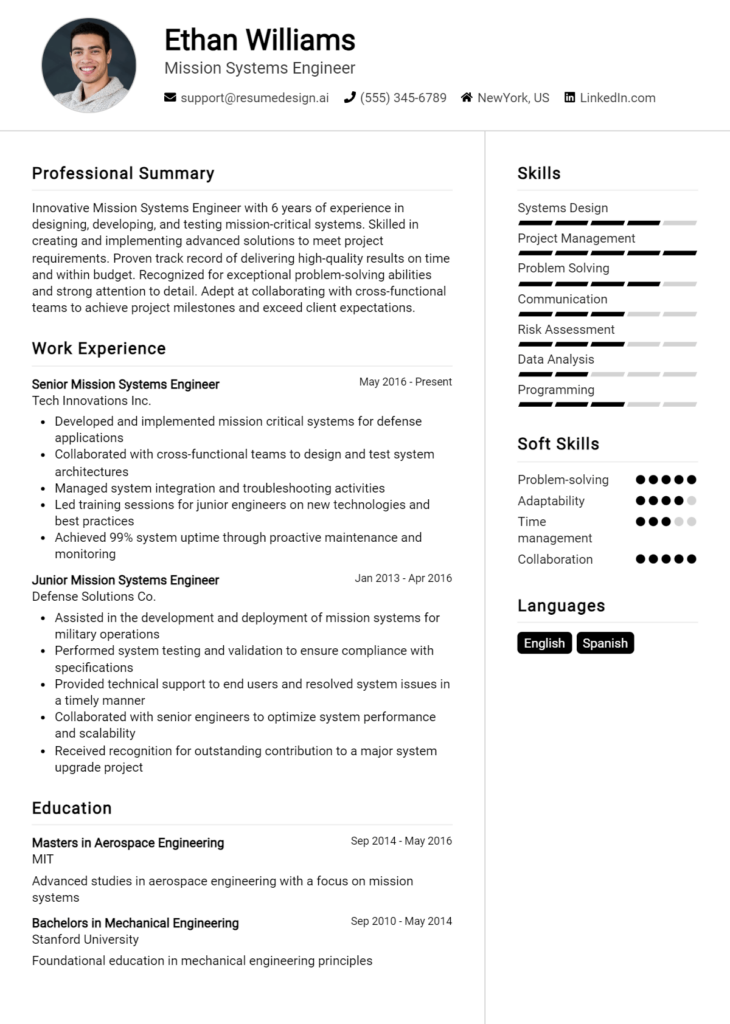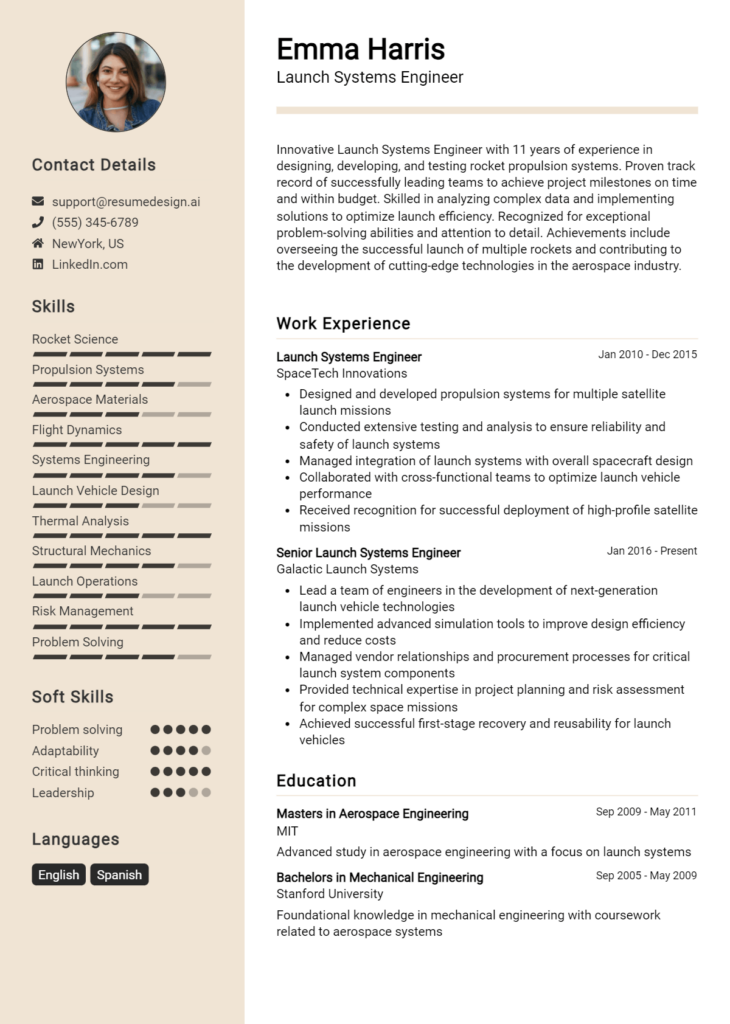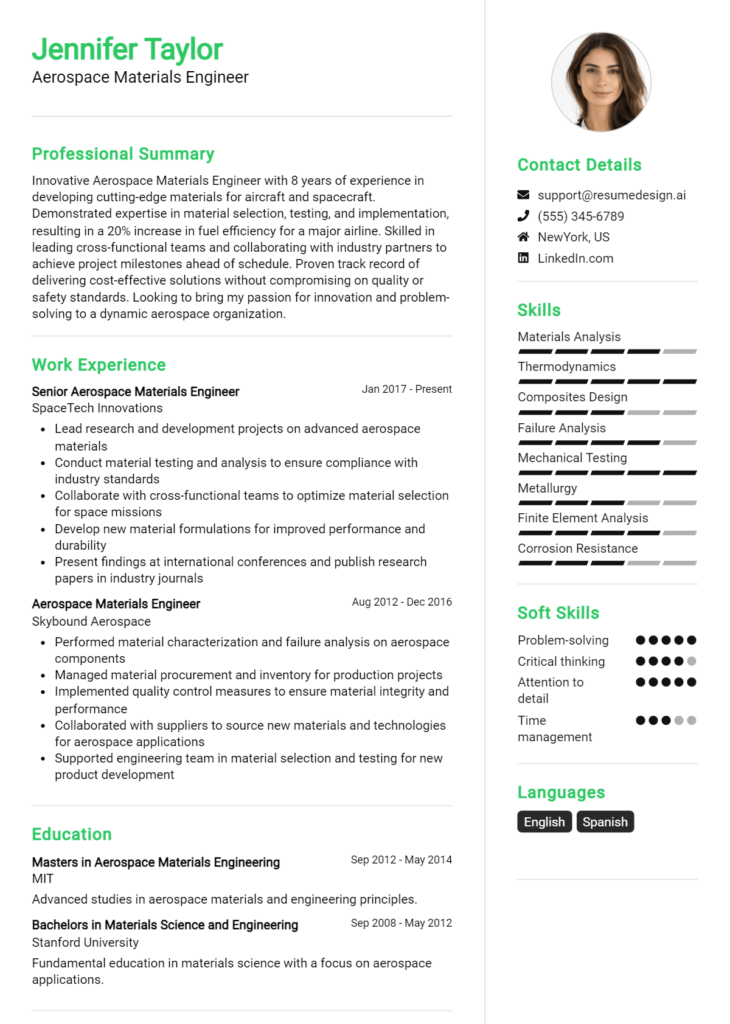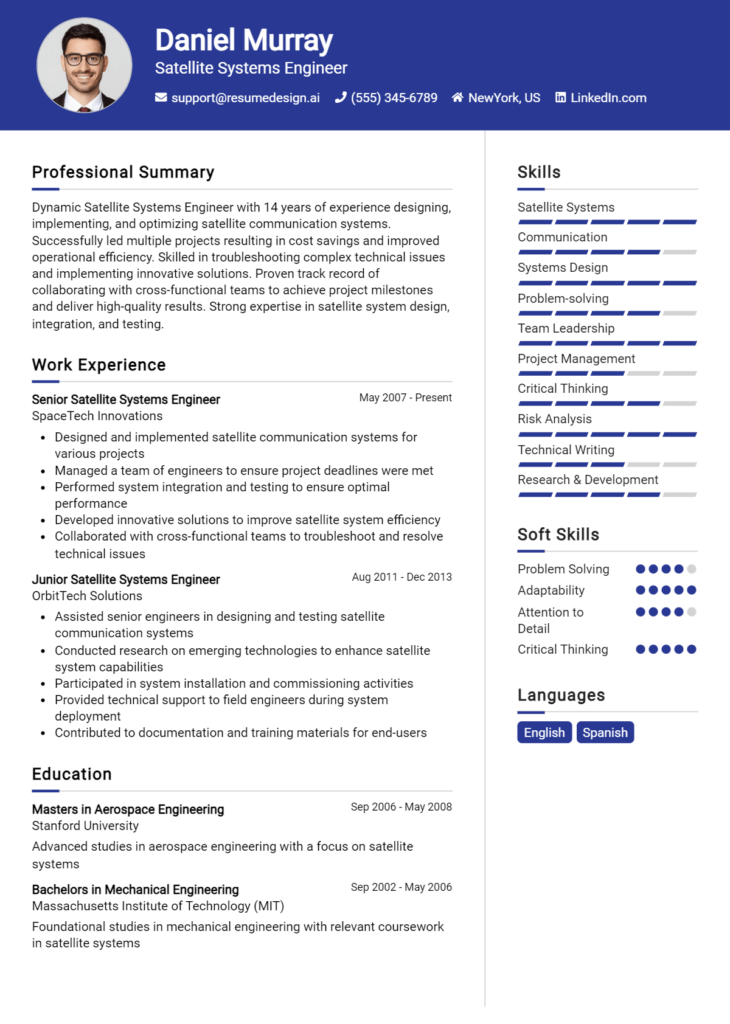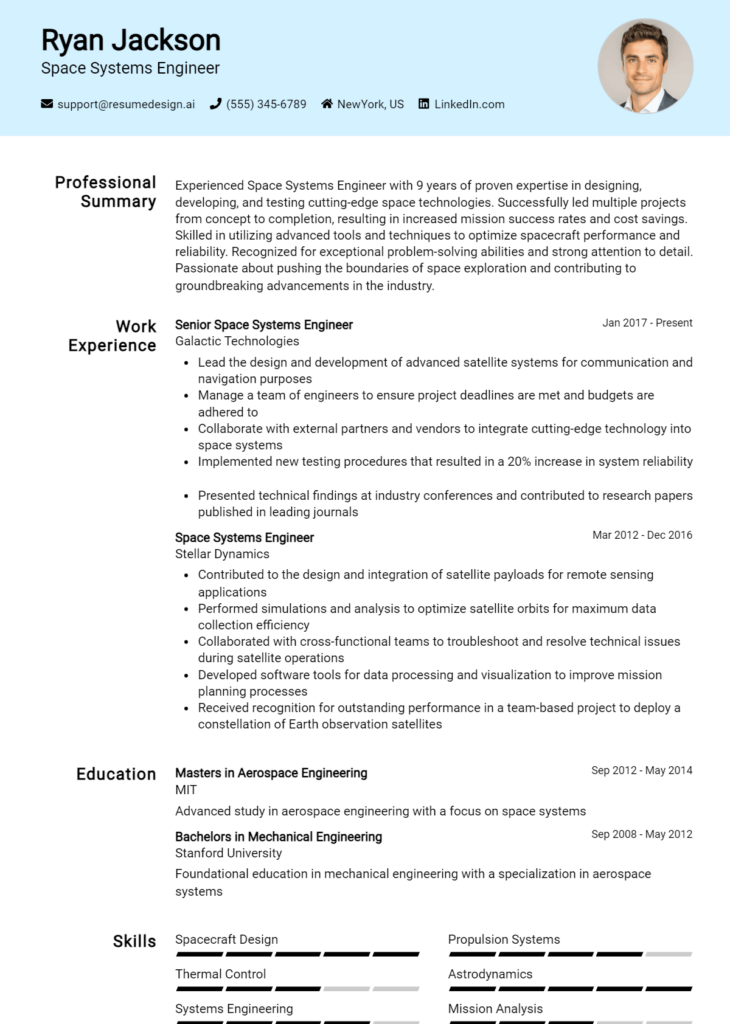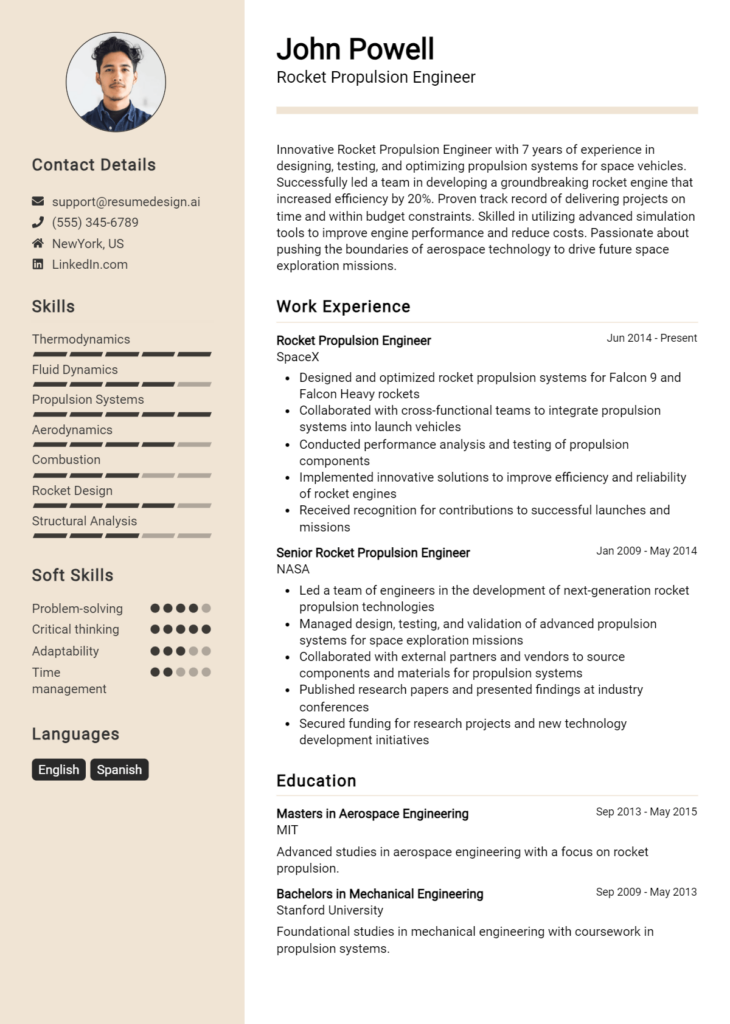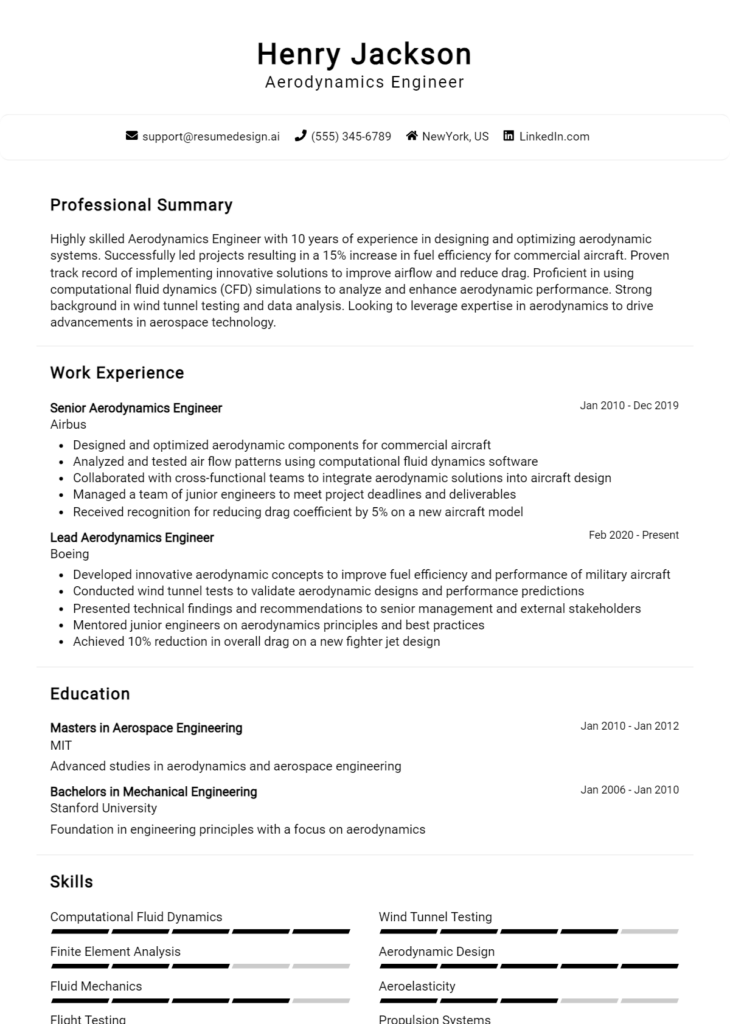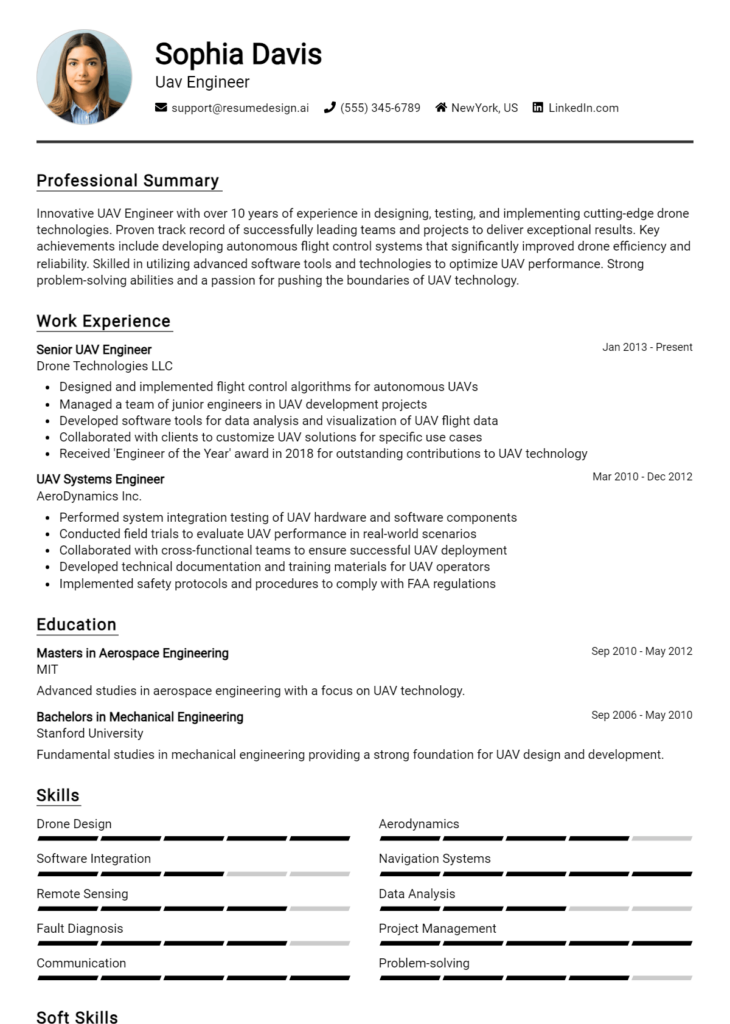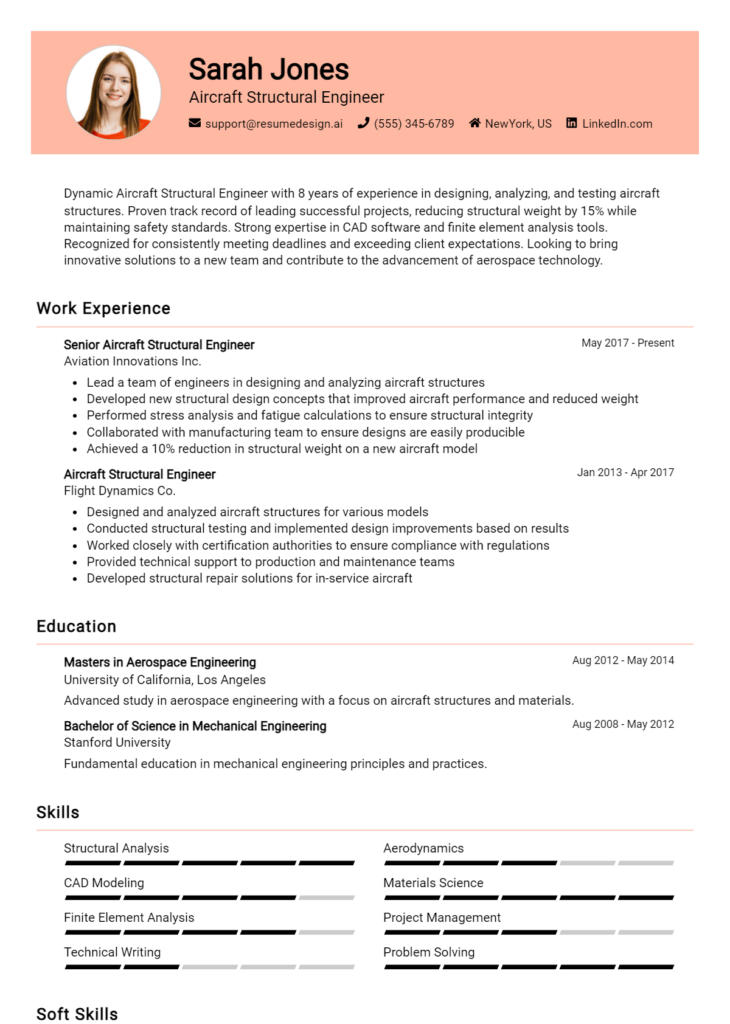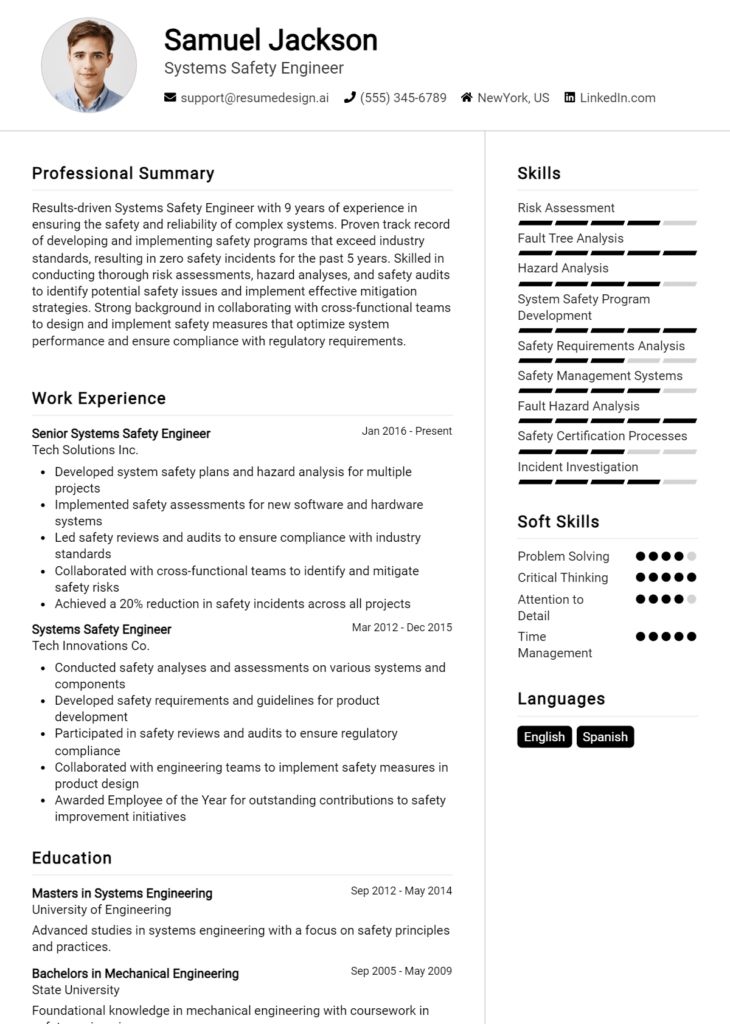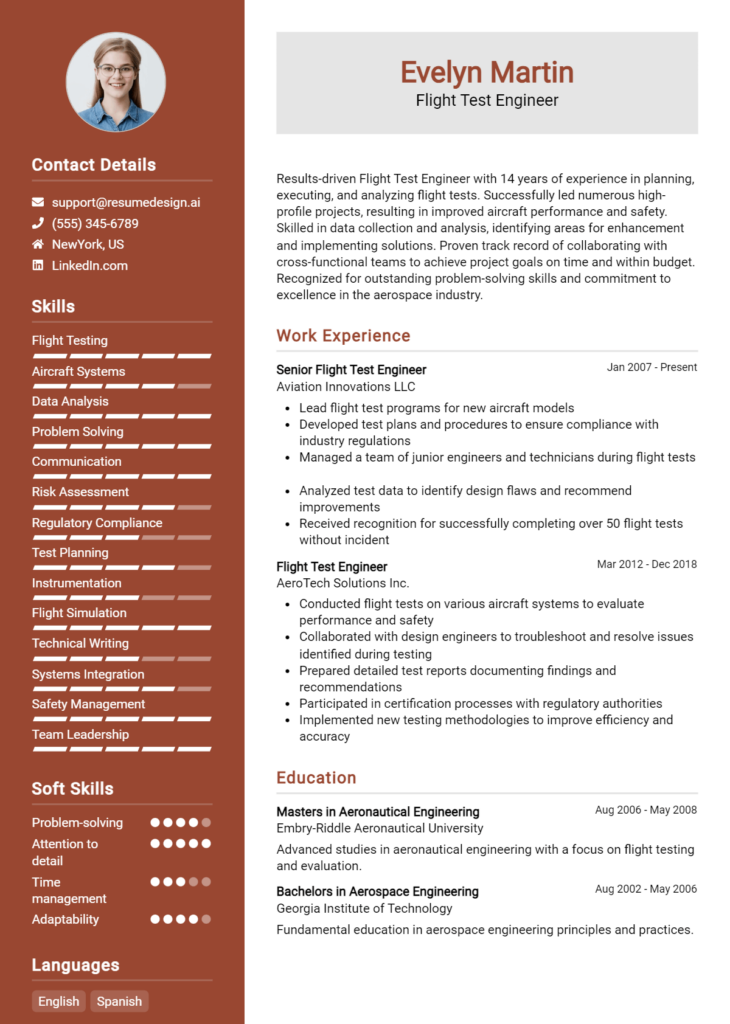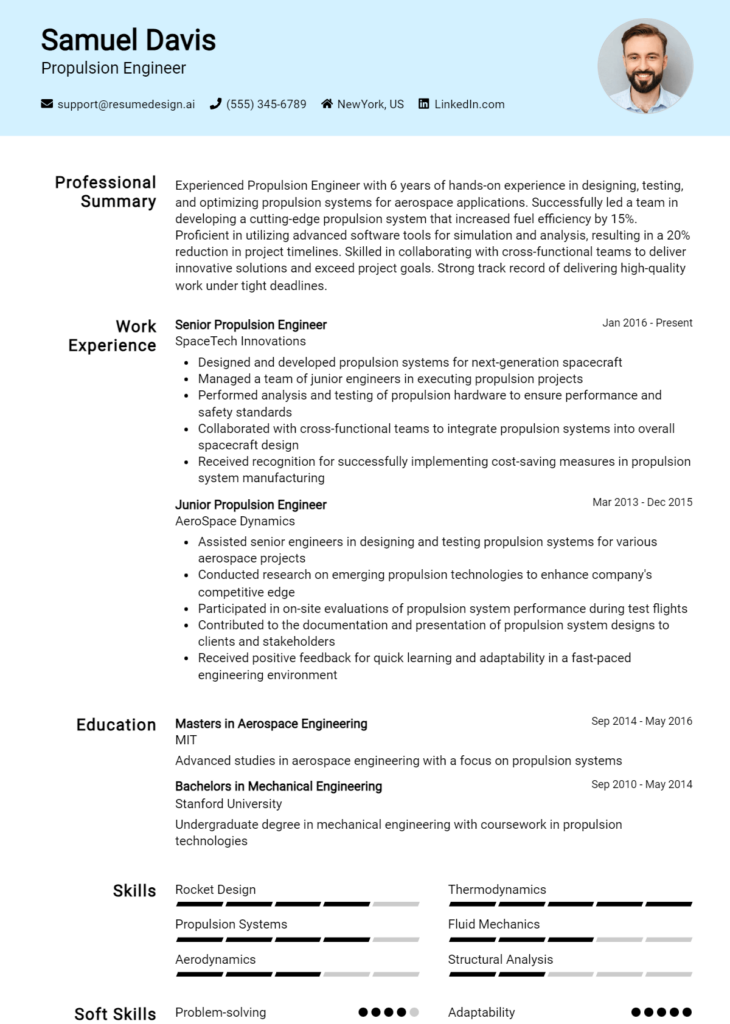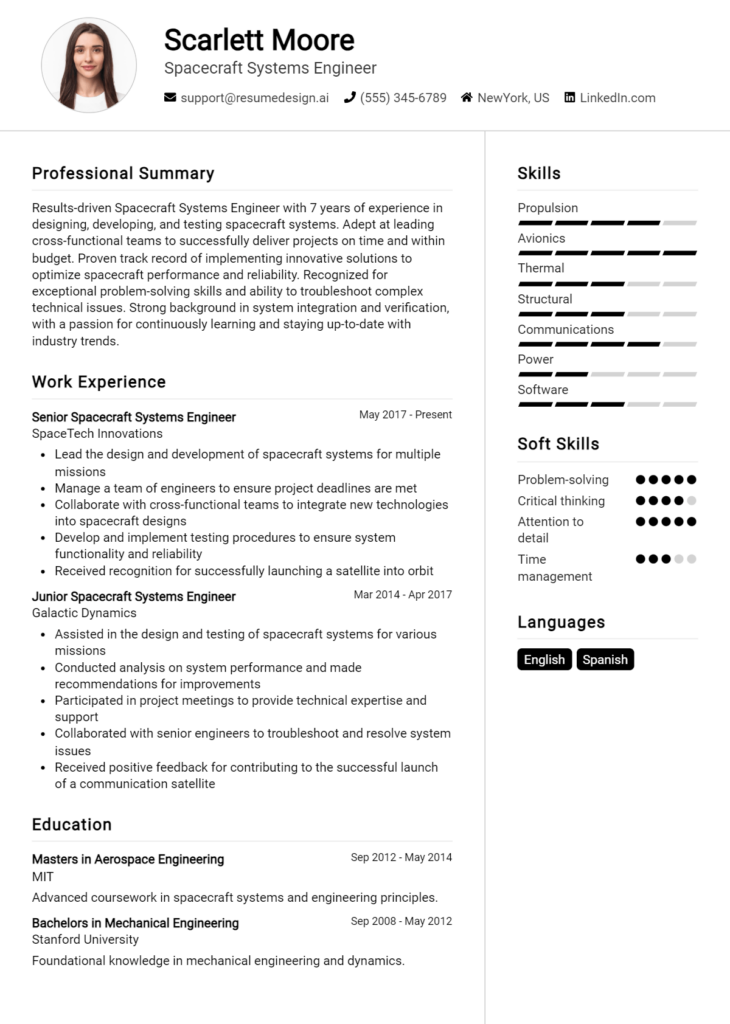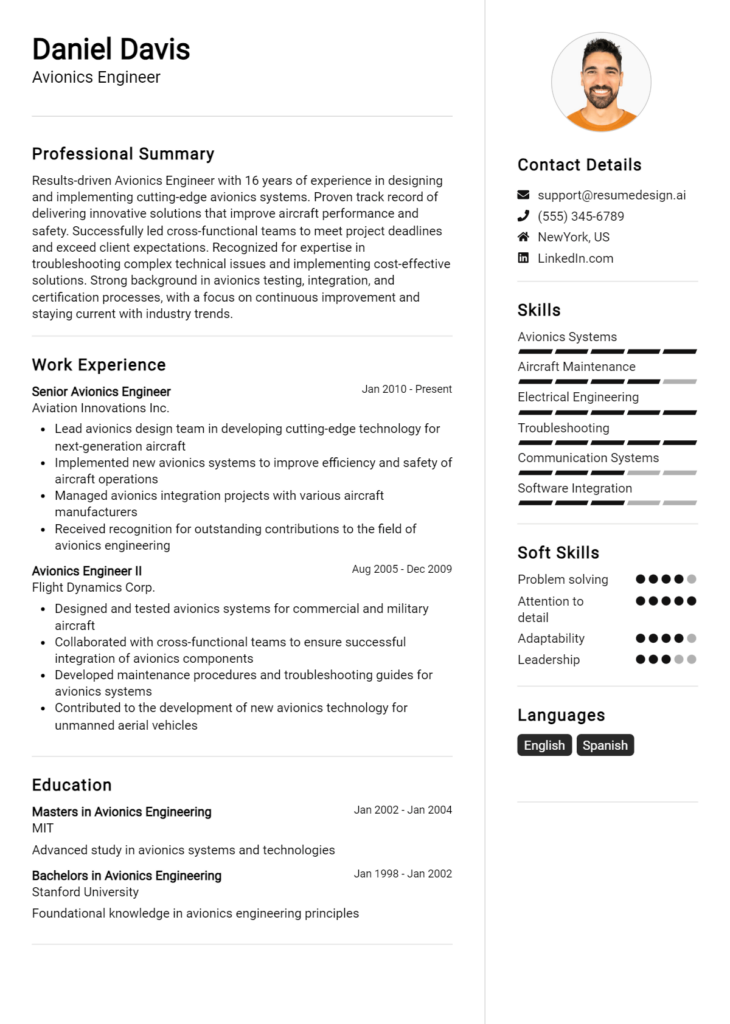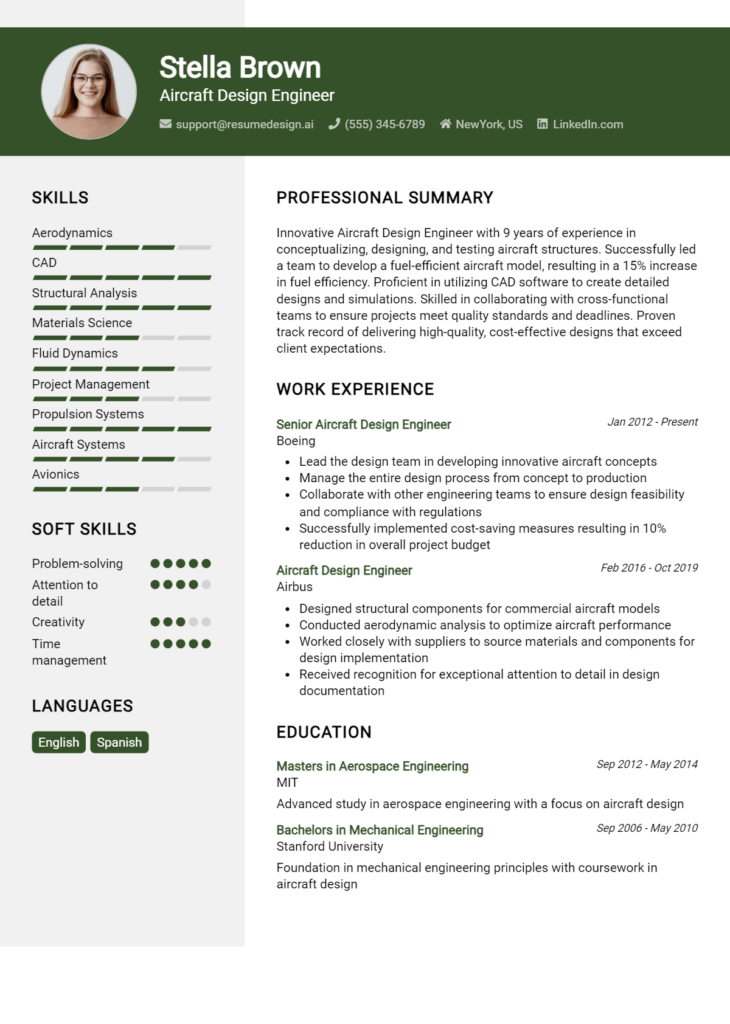Flight Dynamics Engineer Core Responsibilities
A Flight Dynamics Engineer plays a crucial role in the aerospace industry, integrating technical, operational, and problem-solving skills to analyze and optimize flight performance. This role bridges various departments, such as design, testing, and operations, ensuring seamless collaboration to achieve organizational goals. Key responsibilities include developing flight models, conducting simulations, and analyzing data to inform design decisions. A well-structured resume that highlights these qualifications effectively can significantly enhance a candidate’s appeal to potential employers.
Common Responsibilities Listed on Flight Dynamics Engineer Resume
- Developing and validating mathematical flight models.
- Conducting simulations to predict vehicle performance.
- Analyzing flight data to assess operational efficiency.
- Collaborating with design and testing teams for optimization.
- Providing technical support during flight tests.
- Implementing control algorithms for flight navigation.
- Monitoring and troubleshooting flight dynamics issues.
- Documenting and presenting findings to stakeholders.
- Conducting research to improve flight dynamics methodologies.
- Ensuring compliance with aerospace regulations and standards.
- Utilizing software tools for data analysis and modeling.
- Maintaining up-to-date knowledge of industry trends and technologies.
High-Level Resume Tips for Flight Dynamics Engineer Professionals
In the competitive field of aerospace engineering, a well-crafted resume serves as your first and often only chance to make a lasting impression on potential employers. For Flight Dynamics Engineer professionals, this document must encapsulate not only one's technical skills and relevant experience but also showcase achievements that highlight your contributions to past projects. A strong resume can effectively communicate your qualifications and passion for the role, setting you apart from other candidates. This guide is designed to provide practical and actionable resume tips specifically tailored for Flight Dynamics Engineer professionals, ensuring you present the best version of yourself to prospective employers.
Top Resume Tips for Flight Dynamics Engineer Professionals
- Tailor your resume for each job application by incorporating keywords from the job description.
- Highlight your educational background, particularly degrees in aerospace engineering or related fields.
- Showcase relevant experience, including internships, co-op positions, and projects that demonstrate your skills in flight dynamics.
- Quantify your achievements using metrics, such as improved flight stability percentages or reduced simulation time.
- Emphasize industry-specific software proficiency, such as MATLAB, Simulink, or computational fluid dynamics tools.
- Include any certifications or specialized training related to flight dynamics or aerospace engineering.
- Utilize a clean and professional format to enhance readability and make key information easily accessible.
- Incorporate a summary statement that outlines your career goals and what makes you a strong candidate for the role.
- List any publications or presentations that showcase your expertise and contributions to the field.
By implementing these tips, you can significantly enhance the effectiveness of your resume and increase your chances of landing a job in the Flight Dynamics Engineer field. A well-structured and tailored resume not only highlights your qualifications but also reflects your commitment to excellence within this specialized area of aerospace engineering, making you an appealing candidate to potential employers.
Why Resume Headlines & Titles are Important for Flight Dynamics Engineer
In the competitive field of aerospace engineering, specifically for the role of a Flight Dynamics Engineer, crafting an impactful resume headline or title is crucial. A well-formulated headline serves as a powerful first impression, capturing the attention of hiring managers by succinctly summarizing a candidate's key qualifications and expertise. It should be clear, concise, and directly related to the job being applied for, ensuring that it resonates with the specific requirements of the position. A strong headline not only highlights the candidate’s strengths but also sets the tone for the entire resume, making it an essential element for success in the hiring process.
Best Practices for Crafting Resume Headlines for Flight Dynamics Engineer
- Keep it concise: Aim for a brief statement that captures your core expertise in a few words.
- Be role-specific: Tailor your headline to the Flight Dynamics Engineer position you are applying for.
- Highlight key skills: Incorporate technical skills or certifications that are relevant to flight dynamics.
- Use active language: Start with powerful verbs to convey your impact and contributions.
- Include years of experience: If applicable, mention your years of experience in the aerospace sector.
- Avoid generic terms: Steer clear of vague phrases; be specific about your strengths and achievements.
- Showcase unique qualifications: Mention any specialized knowledge, such as software proficiencies or unique methodologies.
- Reflect industry standards: Utilize terminology and phrases commonly recognized in the aerospace industry.
Example Resume Headlines for Flight Dynamics Engineer
Strong Resume Headlines
Dynamic Flight Dynamics Engineer with 10+ Years of Experience in Aerospace Simulation and Analysis
Expert in Control Systems and Stability Analysis for Next-Gen Aircraft
Innovative Flight Dynamics Specialist with Proven Track Record in Enhancing Aircraft Performance
Weak Resume Headlines
Engineer Looking for Opportunities
Experienced Professional in Aerospace
The strong headlines are effective because they are specific, detailed, and directly relevant to the role of a Flight Dynamics Engineer. They highlight the candidate's experience, skills, and contributions, making it easy for hiring managers to see the value they bring. In contrast, the weak headlines fail to impress due to their vagueness and lack of relevant information. They do not provide any insight into the candidate's qualifications or suitability for the position, making it less likely for hiring managers to take notice.
Writing an Exceptional Flight Dynamics Engineer Resume Summary
A well-crafted resume summary is essential for a Flight Dynamics Engineer, as it serves as the first impression a hiring manager will have of a candidate. This brief yet impactful section quickly showcases key skills, relevant experience, and notable accomplishments, effectively capturing the attention of decision-makers. A strong summary is concise and tailored to the specific job being applied for, allowing candidates to highlight their unique qualifications and suitability for the role, which can significantly increase their chances of landing an interview.
Best Practices for Writing a Flight Dynamics Engineer Resume Summary
- Quantify Achievements: Use numbers and metrics to demonstrate your impact, such as successful project completions or efficiency improvements.
- Focus on Relevant Skills: Highlight technical skills and expertise that align with the job description, such as proficiency in specific software or methodologies.
- Tailor the Summary: Customize your summary for each application by incorporating keywords and phrases from the job description.
- Keep it Concise: Aim for 2-4 sentences that deliver a powerful message without overwhelming the reader.
- Showcase Problem-Solving Abilities: Mention experiences where you successfully addressed challenges in flight dynamics or related fields.
- Include Industry-Specific Language: Use terminology that resonates with professionals in aerospace and flight dynamics to convey familiarity with the field.
- Highlight Relevant Certifications: If applicable, include any relevant certifications that enhance your qualifications for the role.
- Convey Enthusiasm: Infuse your summary with a sense of passion for the field, which can make you stand out as a motivated candidate.
Example Flight Dynamics Engineer Resume Summaries
Strong Resume Summaries
Results-driven Flight Dynamics Engineer with over 5 years of experience in developing advanced simulation models that improved aircraft stability by 30%. Proficient in MATLAB and Simulink, with a proven track record of optimizing flight trajectories for unmanned aerial vehicles.
Detail-oriented Flight Dynamics Engineer skilled in applying numerical methods to solve complex flight dynamics problems, achieving a 25% reduction in computational time for simulation processes. Adept at collaborating with cross-functional teams to enhance aircraft performance and safety.
Accomplished Flight Dynamics Engineer with a Master’s degree in Aerospace Engineering and extensive experience in flight test analysis. Successfully led a project that resulted in a 15% increase in fuel efficiency through innovative design modifications.
Innovative Flight Dynamics Engineer with expertise in orbital mechanics and trajectory optimization. Played a key role in a satellite launch project, improving launch accuracy by 20% and contributing to the successful deployment of multiple satellite systems.
Weak Resume Summaries
Experienced engineer looking for opportunities in flight dynamics.
Skilled in various engineering principles and looking to apply my knowledge in a new position.
The strong resume summaries provided above are considered effective because they include specific accomplishments, quantify results, and demonstrate relevant skills tailored to the Flight Dynamics Engineer role. In contrast, the weak summaries lack detail and specificity, making them generic and less impactful. They fail to highlight unique qualifications or demonstrate how the candidate can contribute to the prospective employer's needs.
Work Experience Section for Flight Dynamics Engineer Resume
The work experience section of a Flight Dynamics Engineer resume plays a critical role in demonstrating the candidate's technical expertise and practical application of engineering principles. This section not only highlights the candidate's ability to manage teams and collaborate effectively but also showcases their track record of delivering high-quality products that meet industry standards. By quantifying achievements and aligning experiences with specific industry benchmarks, candidates can provide potential employers with a clear understanding of their capabilities and contributions to previous projects.
Best Practices for Flight Dynamics Engineer Work Experience
- Focus on quantifiable achievements, such as improved flight performance metrics or reduced operational costs.
- Clearly describe your technical skills and the specific tools or software used in your projects.
- Highlight teamwork and leadership roles, showcasing your ability to collaborate with cross-functional teams.
- Align your experiences with industry standards to demonstrate relevance and expertise.
- Use action verbs to convey your contributions and impact in each role.
- Tailor your work experience descriptions to the job description of the position you are applying for.
- Include any certifications or specialized training relevant to flight dynamics engineering.
- Be concise and focused, ensuring each bullet point adds value to your overall narrative.
Example Work Experiences for Flight Dynamics Engineer
Strong Experiences
- Led a team of engineers to develop a new flight control algorithm that improved aircraft stability by 15%, resulting in enhanced safety and performance metrics.
- Implemented a comprehensive simulation framework that reduced design iteration time by 30%, streamlining the development process for multiple airframe modifications.
- Collaborated with cross-disciplinary teams to complete a project ahead of schedule, achieving a 20% reduction in costs while meeting all technical specifications.
- Authored a technical paper on innovative trajectory optimization techniques that was presented at a leading aerospace conference, contributing to industry knowledge and best practices.
Weak Experiences
- Worked on various flight dynamics projects.
- Assisted in simulations and other engineering tasks.
- Participated in meetings with engineering teams.
- Contributed to the development of software tools.
The examples provided illustrate the distinction between strong and weak experiences in the context of a Flight Dynamics Engineer role. Strong experiences are characterized by specific, quantifiable outcomes that demonstrate technical leadership and effective collaboration. In contrast, weak experiences lack detail and fail to convey the candidate's impact or contributions, making them less compelling to potential employers. By focusing on achievements and clarity, candidates can effectively communicate their value in the competitive field of flight dynamics engineering.
Education and Certifications Section for Flight Dynamics Engineer Resume
The education and certifications section of a Flight Dynamics Engineer resume is crucial as it serves as a testament to the candidate's academic qualifications and commitment to professional development. This section not only showcases the foundational knowledge gained through relevant degrees but also highlights industry-recognized certifications and specialized training that are pertinent to the field of flight dynamics. By detailing relevant coursework and ongoing learning efforts, candidates can enhance their credibility and demonstrate alignment with the specific requirements of the job role, making them more appealing to potential employers.
Best Practices for Flight Dynamics Engineer Education and Certifications
- Include degrees from accredited institutions related to aerospace engineering, mechanical engineering, or related fields.
- List industry-recognized certifications such as Certified Flight Dynamics Engineer (CFDE) or similar credentials.
- Highlight relevant coursework that demonstrates specialized knowledge in aerodynamics, stability and control, and trajectory optimization.
- Emphasize any additional training or workshops attended that are relevant to flight dynamics.
- Use clear and concise formatting to present your educational background and certifications effectively.
- Prioritize recent and advanced qualifications over outdated or less relevant ones.
- Tailor the education and certifications section to match the specific job description and requirements.
- Consider including honors or distinctions received during your academic career to further demonstrate excellence.
Example Education and Certifications for Flight Dynamics Engineer
Strong Examples
- M.S. in Aerospace Engineering, Massachusetts Institute of Technology (MIT), 2020
- Certified Flight Dynamics Engineer (CFDE), 2021
- Relevant Coursework: Advanced Aerodynamics, Control Systems Design, and Flight Mechanics
- Professional Development: Workshop on Modern Flight Simulation Techniques, 2022
Weak Examples
- B.A. in History, University of California, 2015
- Certification in Basic Computer Skills, 2019
- Relevant Coursework: Introduction to Psychology
- Outdated Certification: Private Pilot License, 2008
The strong examples are considered effective because they reflect relevant degrees and certifications directly linked to the Flight Dynamics Engineer role, showcasing the candidate's expertise and commitment to the field. In contrast, the weak examples demonstrate a lack of relevance to the industry, featuring degrees and certifications that do not align with the necessary qualifications for a Flight Dynamics Engineer, ultimately diminishing the candidate's appeal to potential employers.
Top Skills & Keywords for Flight Dynamics Engineer Resume
As a Flight Dynamics Engineer, possessing the right skills is essential for success in this highly specialized field. A well-crafted resume that showcases both hard and soft skills can make a significant difference in standing out to potential employers. Hard skills demonstrate your technical expertise and proficiency in relevant tools and methodologies, while soft skills highlight your ability to collaborate, communicate, and solve problems effectively. Together, these competencies form a comprehensive picture of your qualifications, making it easier for hiring managers to see your potential contributions to their team. For those looking to enhance their resumes, focusing on the right skills and relevant work experience is crucial.
Top Hard & Soft Skills for Flight Dynamics Engineer
Hard Skills
- Flight mechanics analysis
- Simulation software proficiency (e.g., MATLAB, Simulink)
- Astrodynamics and orbital mechanics
- Control systems design
- Aerodynamics principles
- Software development (C/C++, Python)
- Data analysis and modeling
- Flight test planning and execution
- System identification techniques
- Numerical methods and algorithms
- Performance analysis and optimization
- Radar and sensor data interpretation
- Multivariable control theory
- Computational fluid dynamics (CFD)
- Navigation systems design
- Conformance with aviation regulations
- Technical documentation and reporting
Soft Skills
- Problem-solving abilities
- Effective communication skills
- Team collaboration and leadership
- Attention to detail
- Adaptability and flexibility
- Critical thinking
- Time management
- Project management
- Analytical and strategic thinking
- Creativity and innovation
- Conflict resolution
- Interpersonal skills
- Self-motivation and initiative
- Decision-making capabilities
- Willingness to learn and develop
- Patience and perseverance
- Networking and relationship building
Stand Out with a Winning Flight Dynamics Engineer Cover Letter
Dear Hiring Manager,
I am writing to express my interest in the Flight Dynamics Engineer position at [Company Name], as advertised on [Job Board/Company Website]. With a solid foundation in aerospace engineering and specialized experience in flight dynamics, I am excited about the opportunity to contribute to your team. My background includes extensive work in modeling, simulation, and control systems for various aircraft types, which I believe aligns perfectly with the innovative projects at [Company Name].
During my tenure at [Previous Company], I was responsible for developing and validating flight dynamics models for unmanned aerial vehicles (UAVs). This role required a deep understanding of aerodynamic principles and control theory, enabling me to optimize flight performance and ensure compliance with safety standards. I successfully led a team that reduced simulation time by 30% through the implementation of advanced algorithms, which improved our design process and enhanced the overall efficacy of our projects. I am adept at using software tools such as MATLAB and Simulink for modeling and analysis, and I am committed to staying updated with the latest industry advancements.
I am particularly drawn to [Company Name] because of your commitment to innovation and excellence in aerospace design. I admire your recent projects in [specific project or technology], and I am eager to bring my expertise in flight dynamics to contribute to such groundbreaking work. I believe my analytical skills, attention to detail, and passion for aviation will allow me to make a meaningful impact on your team.
Thank you for considering my application. I look forward to the opportunity to discuss how my background, skills, and enthusiasm for flight dynamics can contribute to the success of [Company Name]. I am excited about the possibility of joining your team and am confident that my experience aligns well with your needs.
Sincerely,
[Your Name]
[Your Contact Information]
[LinkedIn Profile or Portfolio URL]
Common Mistakes to Avoid in a Flight Dynamics Engineer Resume
When crafting a resume for a Flight Dynamics Engineer position, it's crucial to present a clear, concise, and relevant account of your skills and experiences. However, many candidates fall into common pitfalls that can detract from their qualifications and make their applications less compelling. Avoiding these mistakes can significantly enhance your chances of capturing the attention of hiring managers in this specialized field.
Lack of Specificity: Generalizing experiences rather than detailing specific projects or technologies can make your resume blend in with others. Highlight unique contributions and results to stand out.
Ignoring Keywords: Failing to incorporate relevant industry keywords can lead to your resume being overlooked by Applicant Tracking Systems (ATS). Review job descriptions carefully and use the same terminology.
Overly Technical Language: While technical proficiency is essential, using excessively complex jargon can alienate non-specialist reviewers. Aim for a balance that showcases your expertise while remaining accessible.
Neglecting Soft Skills: Focusing solely on technical skills can be a mistake. Flight Dynamics Engineers often work in teams, so it's important to highlight communication, problem-solving, and collaboration skills.
Unorganized Format: A cluttered or poorly structured resume can hinder readability. Use clear headings, bullet points, and consistent formatting to ensure your qualifications are easy to digest.
Omitting Relevant Certifications: Failing to list important certifications or licenses specific to flight dynamics can weaken your application. Ensure you include all relevant qualifications that validate your expertise.
Excessive Length: A resume that is too long may lose the reader's interest. Aim for a concise document that effectively summarizes your experience in one to two pages.
Neglecting to Tailor Your Resume: Submitting a generic resume for every application can diminish your chances. Customize your resume to align with the specific requirements and responsibilities outlined in each job description.
Conclusion
As a Flight Dynamics Engineer, you play a pivotal role in the design and analysis of flight systems, ensuring that aircraft and spacecraft operate efficiently and safely. Throughout this article, we've explored the essential skills required for this position, including proficiency in aerodynamics, control systems, and simulation tools. You’ve also learned about the importance of collaboration with multidisciplinary teams and the need for continuous professional development in this rapidly evolving field.
To succeed in securing your desired position as a Flight Dynamics Engineer, it is crucial to have a polished and impactful resume that highlights your technical expertise and relevant experience. We encourage you to take action today by reviewing and updating your resume to reflect your qualifications effectively.
Make use of the available resources to enhance your resume:
- Check out various resume templates to find a design that suits your professional style.
- Utilize the resume builder for an easy and guided way to create a standout resume.
- Browse through resume examples to gain inspiration from successful Flight Dynamics Engineers.
- Consider drafting a compelling cover letter with the help of cover letter templates that can complement your resume.
Take the first step towards advancing your career in flight dynamics by ensuring your resume is as dynamic as the field itself!

